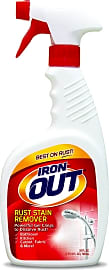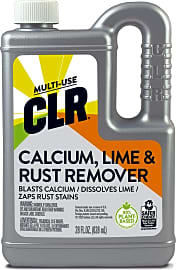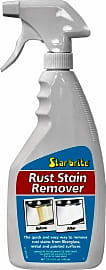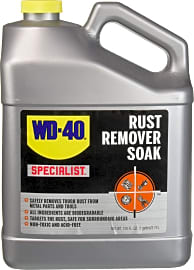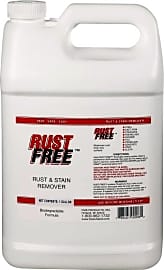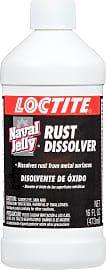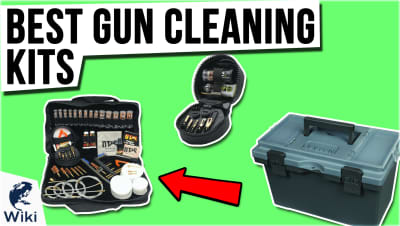The 10 Best Rust Removers

This wiki has been updated 40 times since it was first published in June of 2016. If you have taken on the challenge of restoring a classic automobile, you're definitely going to need one of these rust removers to help give that machine its original shine back. Of course, they are also excellent for many household uses, too, like the removal of hard water stains on a tub and corrosion on old tools. Be aware, though, some of these are toxic chemicals and must be used with care. When users buy our independently chosen editorial selections, we may earn commissions to help fund the Wiki.
Editor's Notes
November 23, 2020:
Getting rid of corrosion and rust stains doesn't have to be a laborious task that requires heavy scrubbing. Instead, you can use one of the rust removers on this list to make the process hassle-free, and, often, without having to put in any elbow grease.
We tend to be very eco-conscious here, so we often lean towards items and products that won't harm the environment or which were produced in a socially responsible method. In the case of rust removers, that means we did our best to find formulas that are fully biodegradable, but no less effective than caustic solutions that contain acids or other potentially harmful chemicals. Some examples of the former are Evapo-Rust; Calcium, Lime, Rust; Innoshine B570, Star Brite, and Workshop Hero Metal Rescue. Not only will these not harm the environment, but you don't have to worry about them releasing toxic chemicals, so you can feel safe using them inside your home. Innoshine B570 is even made entirely with organic ingredients, making it ideal for food preparation areas, and Calcium, Lime, Rust is 70-percent plant based.
While the above options have all proven to be very effective, there are times when you may prefer to use something a bit more aggressive, either because you need to produce results very quickly or the corrosion is so heavy that other formulas simply haven't worked. In these instances, you can try Boeshield Rust Free or Loctite Naval Jelly. Both of these are very potent, which means they should be able to get rid of even the most stubborn of rust issues, however they also have the potential to damage some surfaces. Both can dull or strip paint if left on too long, and the former cannot be used on black oxide tools. They can both damage chrome too, if not used judiciously. Additionally, they can be harmful to humans if they come into contact with the skin or the fumes are inhaled, so you should always use these in a well-ventilated area, and while wearing gloves, safety glasses, and a respirator.
Even if using one of the less-aggressive solutions, it is always important to read the manufacturer's guidelines on proper usage and safety warnings to ensure you are using the product in the intended way. Otherwise you risk potentially hurting yourself or the material you are trying to clean.
June 11, 2019:
Those who have never used a rust remover to get rid of corrosion before may think it is an impossible task, but all of the options on this list would prove that person wrong. It can actually be much easier than most people think, and often requires no scrubbing what so ever. If you are looking for a safe, all-purpose option, there are few better choices than Calcium, Lime, Rust Pro. It can used on practically everything, from porcelain to cookware to cement, and is part of the EPA’s Safer Choice Program. Evapo-Rust, Innoshine B570, Workshop Hero Metal Rescue, and WD-40 Specialist are also all non-toxic, biodegradable, and won't harm skin. While the first two are fast-acting options, Workshop Hero Metal Rescue and WD-40 Specialist often require extended periods of soaking, depending on the severity of the corrosion. Conveniently, none of these formulas will harm paint, either.
We realize that some people may have need for a more specialized solution, which is why we included Summit Brands Iron Out Gel, Loctite Naval Jelly, Star Brite, and Whink 1081. As you probably guessed by the names, Summit Brands Iron Out Gel and Loctite Naval Jelly are thick formulas that cling well to vertical surfaces. Along with Whink 1081, Summit Brands Iron Out Gel is best used on fabrics, carpets, and white porcelain surfaces. Loctite Naval Jelly is designed for use solely on ferrous metals, and is very effective for its intended application. Star Brite is an acid-free formula that is designed for use in marine applications, such as removing rust stains dripping down fiberglass hulls.
When applicable, we have tried to point out which solutions are acidic or potentially harmful in some way, though we still recommend you always read the manufacturer's warnings before beginning to use any rust remover.
Rust: The Silent Killer
Outdoor fixtures like furniture and fences, often made from wrought iron, can easily oxidize in humid climates.
It doesn't happen overnight. There's no sudden turning point when rust becomes a problem. It creeps into your life over many nights, slowly, as oxygen and moisture circulate through the air and rest on steel surfaces. Without a sound, the metal reacts with the atmosphere and begins to corrode. Rust can sneak into any garage or toolbox given time and inactivity. Of course, an ounce of prevention is worth a pound of cure, but when corrosion gets intense and metal starts to flake, it can cause a lot of problems.
Simple hand tools can become unusable if they're caked and flaking. Disfigured nuts and bolts marred by red-orange deposits can see use again, but they'll need some help. Saw blades, knives, scissors, and pliers all need to be rust-free to work properly.
Home and property owners will find a lot of uses for a quality rust remover. Bathrooms, of course, are notorious for corrosion due to all the moisture. Plumbing fixtures, faucets, and even toilet bowls are in danger of discoloration or damage, especially in the presence of hard water. Major appliances, whether in the kitchen, outdoors, or in the basement, are subject to constant use and extreme conditions. Driveways and parking lots often develop rust stains thanks to leaks from cars, and the right chemical can get rid of those blemishes. Outdoor fixtures like furniture and fences, often made from wrought iron, can easily oxidize in humid climates.
Cars can benefit from proper treatment in a few ways. Rust attacks vehicles in three main places: the engine bay, the undercarriage, and the body. Keeping corrosion out of your engine bay will extend the life of your car's most sensitive components. A rust-free underbody ensures that important parts like brakes, steering, and suspension stay in working order, keeping your driving experience safe. And body panels with no holes eaten out of them keep your car looking good while helping to prevent those internal oxidation infections.
Rust removers even have utility for collectors and artists. Antiques, especially guns, can suffer from discoloration and damage because of the older types of metal used in their construction. And there's nothing quite like a truly old piece of antique jewelry that's been restored to its former beauty.
Rust is so common, it might even cause you to wonder: what exactly am I removing?
What Is Rust, Anyway?
Time for a little science. Rust is a slow-acting reduction-oxidation reaction, also known as a redox. A redox is a chemical reaction where the involved particles alter their electron states. When two substances swap electrons, heat is released and one or more chemical products are formed. These reactions represent phenomena as simple as the formation of carbon dioxide and as complex as our body breaking down nutrients into raw cellular fuel.
As the iron is exposed to oxygen in the air, it slowly loses electrons, known as oxidizing.
Iron, the main component of steel, provides a good example of this process. As the iron is exposed to oxygen in the air, it slowly loses electrons, known as oxidizing. If there's water (liquid or vapor) in contact with the iron, the increase in available oxygen speeds up the process. The oxygen molecule gains those electrons in a step called reduction, and two products are created: heat and iron oxide. Iron oxide, of course, is none other than rust, the red devil itself.
Interestingly, another common example of a redox is fire. While rust is a slow reaction, fire is a very fast one. Rather than converting the fuel to an oxide slowly over time, fire does so with the help of intense heat to get it started. Once this happens, electrons are ripped from the fuel source so quickly that the process propagates itself, as the heat from the highly exothermic redox greatly increases the availability of free oxygen molecules in the air that serve as the reaction's oxidant.
This is very similar to the reaction that causes your car's body panels to turn reddish-brown, even if it's got a little more spark behind it. Indeed, cellular respiration, the rusting of an antique, and the burning of a campfire are all chemically similar, which is why rust is often called the slow fire.
What To Look For In A Chemical
Metal is usually pretty strong stuff, and rust is awfully difficult to physically remove from any specimen. It takes a lot of sanding and grinding to scrape a serious rust infestation off an old body panel, if it's possible at all. Nobody will blame you if you'd rather not spend an extra half-hour scrubbing the red stuff off all the specialized nuts and bolts needed to put your car back together once it's repaired.
If and when rust does invade your tools, cars, or house, there's a rust remover out there that will surely make your life easier.
There's no shortage of products on the market to replace that elbow grease. In fact, there are quite a few, and different types can serve different purposes. Some compounds as simple as vinegar work to remove rust, but might not be as effective as more powerful chemicals. Lubricating solvents similar to the household WD-40 do a decent job of removing rust.
While some products are designed for soaking the afflicted parts, others come in spray bottles and attack surface corrosion and discoloration. Some of these spray-on options include solvents effective against a range of chemicals that form deposits, making them perfect for kitchens and bathrooms.
Pay close attention to two important issues: any health hazards created by your chemical of choice, as well as its environmental toxicity. Especially if the runoff from your cleaning process will come anywhere near your lawn, garden, greywater tank, or groundwater source, it's imperative to find a non-toxic offering. Similarly, some chemicals absolutely require good ventilation, otherwise eye, throat, and lung damage could occur before you've even finished the project.
Remember to keep everything properly oiled and protected from the elements to minimize contact between metal and oxygen. If and when rust does invade your tools, cars, or house, there's a rust remover out there that will surely make your life easier.


